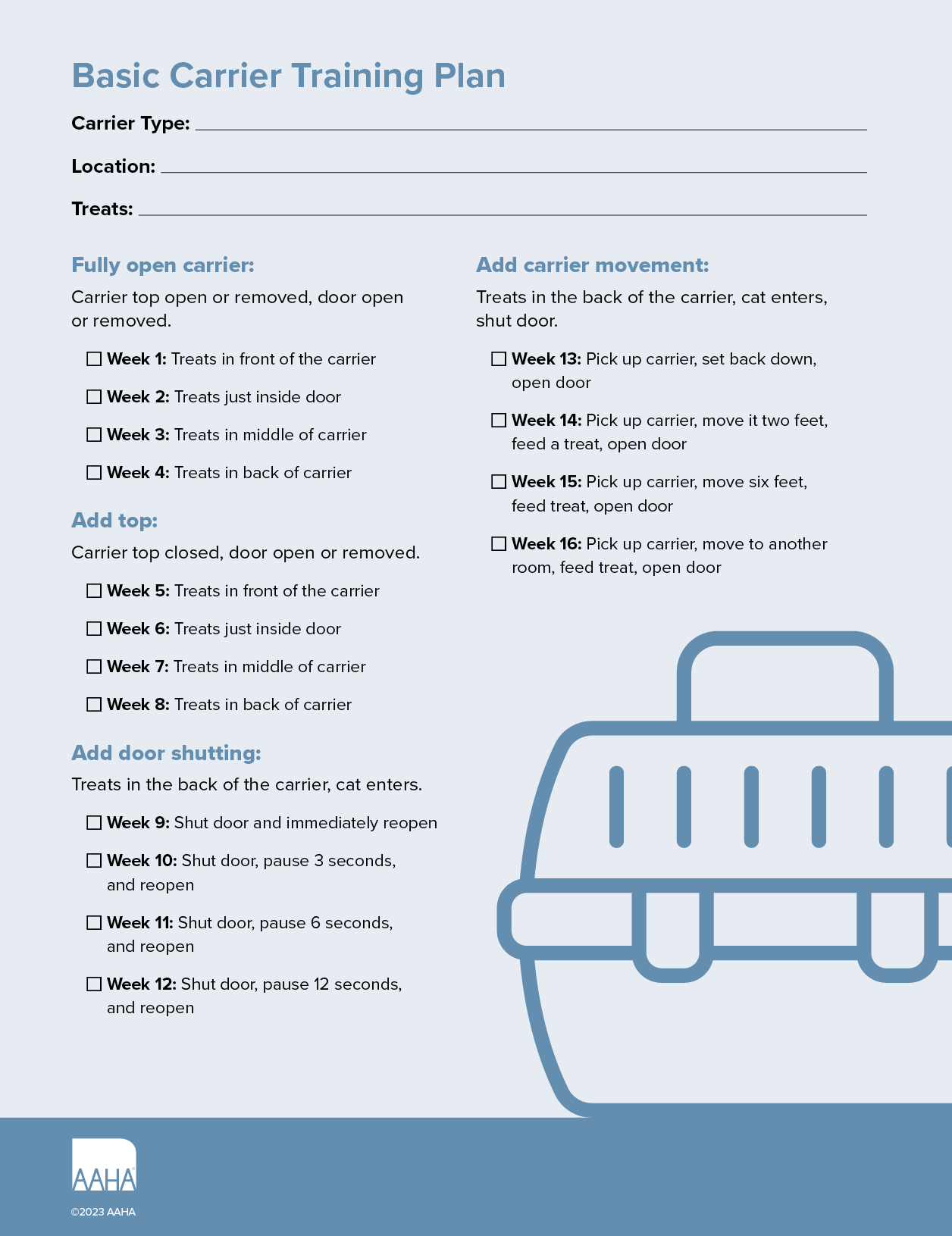A Better Cat Visit
Caregivers and Carriers are the Keys to Improved Cat Care
by Sherrie Yuschak, RVT, VTS (Behavior), KPA-CTP
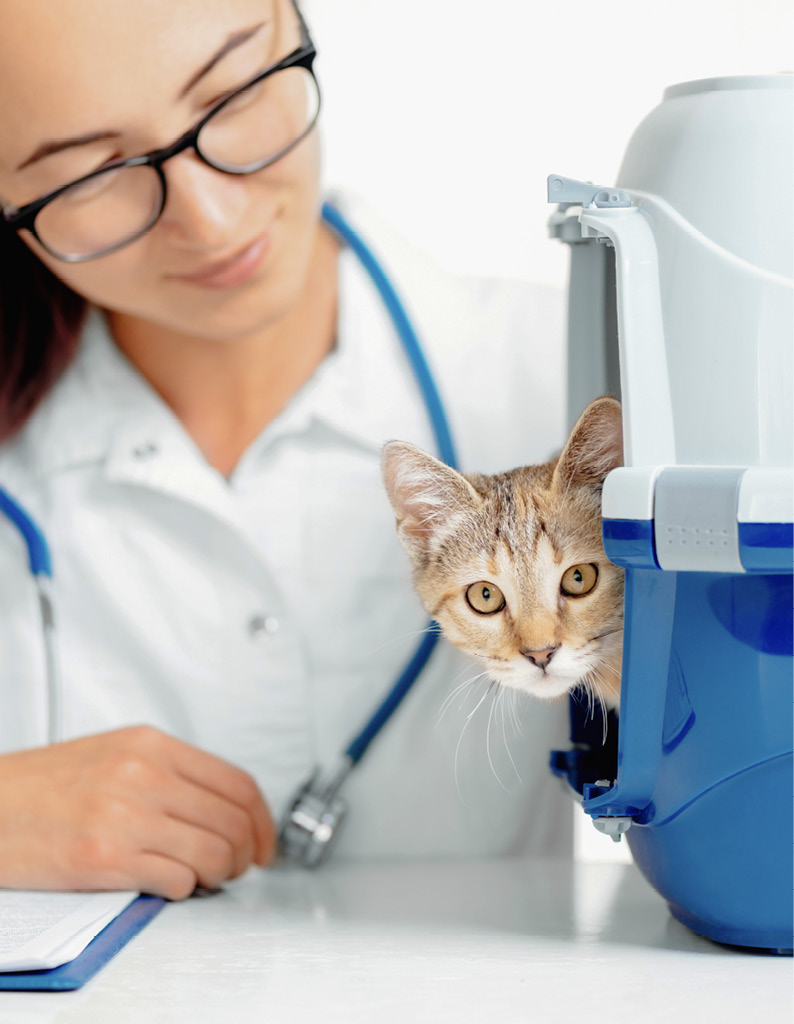
Tip: If a cat is fearful of their current carrier, switching to a new type when starting the training process can be helpful.
Within two human generations, cats have purred themselves into the family circle. They’ve moved indoors and developed passionate caregivers. Social media, a snapshot of modern priorities, is dominated by frolicking kittens, silly cat antics, and precious moments of feline affection and snuggles. As evidence of caregiver commitment and kitty comfort, it’s increasingly common to hear of people skipping events to stay home with their cat or bending over backward to avoid disrupting the cat sleeping on their arm.
Statistics from pet products industries confirm cat caregivers’ willingness to spend billions of hard-earned dollars on their cat, purchasing fancy litterboxes, tasty treats, and premium food. But there is a disconnect when it comes to the veterinary side of things. Spending on vet care for pet cats is half as much as it is for dogs. Many veterinary clients who care for dogs also have cats. These caregivers are experienced with veterinary care and already have a relationship with a veterinarian. So, where are the cats?
During research studies, clients revealed several reasons their cat leaps over vet care. They feel their cat is self-reliant, doesn’t go outside (and therefore has low health risk), and doesn’t seem ill. Sadly, they also report skipping vet visits because the cat resists and becomes very stressed. Almost 40% of cat caregivers say just thinking about taking the cat to the vet causes them stress.
Printable Handout for
|
Overcoming Carrier-Phobia
Targeted education can help clients recognize how indoor, seemingly healthy cats can benefit from veterinary exams. But if the client dreads the very thought of bringing their cat to a vet, achieving optimal wellness care is a nonstarter.
Getting the cat into the carrier is the first phase of veterinary visit. It seems separate and unrelated as the cat is at home with no veterinary team members or diagnostics in sight. The cat, basking in an afternoon sunbeam, sees the carrier come from the garage. The client approaches the cat, picks them up, and stuffs them into the carrier. Without a chance to acclimate to the carrier’s presence or a choice to approach and investigate, the cat becomes stressed. When the door closes behind the cat and escape is no longer an option, panic can ensue. And that is the simplest scenario. Often, the cat is chased, pulled out of hiding, restrained, and wrestled into the carrier. Sometimes this sequence repeats more than once.
Stories like these are commonly shared by friends, family, and even some veterinary professionals. Reasons are stated that cats don’t like change, cats can’t be trained, and it’s normal for pets to dislike the vet. Commissary and admission are added about how they too struggle to get their cat into the carrier. Ultimately, the pressure falls onto the cat caregiver because if they can’t get the cat into the carrier, vet care won’t occur. Frustration, fear, physical pain, and injury risk that may occur before even leaving home are strong motivators to avoid scheduling an appointment at all.
Consider an alternative scenario. The cat sees the client approach the carrier with a treat. The cat chirps, runs ahead, quickly enters the carrier, and eats their treat as the door shuts. Would that client dread and avoid wellness care for this cat? Would the cat arrive to the visit more relaxed and cooperative for handling? Would the exam be more thorough, diagnostics more accurate, and client compliance enhanced?
Cats can be taught that carriers are a safe, comfortable space. As a species, they naturally seek small spaces to rest. Cats are also curious critters who love to eat. Many enjoy chasing toys into and under small spaces. These fabulous traits simplify carrier training. Starting as kittens, this should be planned as part of socialization. With fewer stressful experiences, carrier training can progress quickly. Adult cats can absolutely learn to enjoy the carrier. Overcoming any previous aversive experiences may take a bit more patience.
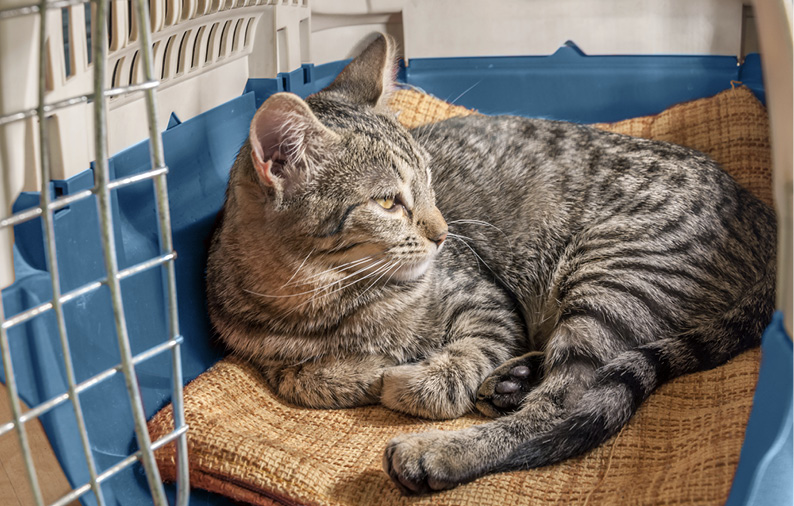
Adult cats can absolutely learn to enjoy the carrier. Overcoming any previous aversive experiences may take a bit more patience.
Clients do not need advanced training skills to carrier-train their cat. Feeding their cat meals and treats is already part of the daily routine and only minor strategy changes are needed (see included basic plan at the end of this article). Cats who have a severe reaction to the carrier or are slow to progress through the plan can be further assisted by a behavior consultant or credentialed trainer. Anti-anxiety nutraceuticals or medications can be added to the training plan to decrease fear, enhance new learning, and smooth future visits.
Because the carrier is a pivotal component of the cat and client’s vet care experience, coaching clients to choose the best type is important. Advise clients that the most important feature is an easily opened top. Adding cat access doors helps during training, examining the cat within the carrier, and placing and removing them with less stress. Large carriers with removable tops provide extra space for an exam to occur within the bottom half. Some carriers have a bottom that slides out like a drawer, and mesh carriers allow for a sedation (or medication) injection to occur without removing the cat. Like choosing cat food, carrier choice should be customized to the cat’s specific preferences and needs and not simply price point.
Tip: If a cat is fearful of their current carrier, switching to a new type when starting the training process can be helpful.
Small, simple additions and adaptations enhance the carrier experience. Consider scent, sound, and traction during transport. A carrier that was last used for a stressful event may contain pheromones of fear and should be cleaned with a mild, unscented detergent. Synthetic calming feline pheromones can be sprayed once cleaned. Add a towel, blanket, or mat the cat has already slept on to provide familiar scents, and place a nonslip shelf liner underneath. When animals slip, slide, and struggle to balance, stress will increase. Erratic, rushed driving and loud, fast music stimulates the nervous system. Encourage clients to prioritize adequate travel time to decrease their own stress and play spa music, calming music designed for pets, or talk radio. Putting the carrier on the floor of the back seat is a secure spot to minimize shifting. When carrying the cat, be mindful to keep the carrier level. Holding it from the bottom keeps the cat centered and stable while using the handle swings the carrier and leans the cat to the side.
Improved Visits: The Practice Team
The emotions and behavior elicited during carrier transport impact the exam and procedures. Stress is cumulative as behavior escalates accordingly. Thoughtful feline-specific considerations within the facility and a gentle handling plan can minimize stress. Adding aspects to exam rooms that the cat finds enjoyable—such as cheek scratches, treats, toys, catnip or silvervine, cardboard boxes, perches, nonslip surfaces, and warm blankets—are all helpful to create positive associations. Approaching and greeting slowly and quietly, examining the cat wherever they are comfortable, taking breaks, and being efficient during procedures also enable stress reduction.
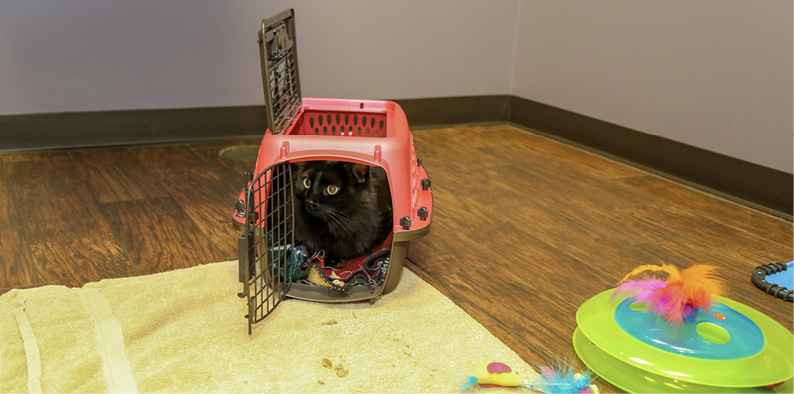 Team training to recognize the subtlest signs a cat is becoming stressed and learning various ways to adapt the environment and handling plan is a sound investment. Clients do not want to see their pets scared and hiding or struggling to get away. Vocalizations of distress and aggressive displays are greatly upsetting. The cat may have never expressed this behavior, and to see this side of them can frighten the client. Some clients are embarrassed, frustrated, or worried their cat may hurt someone. The client can rationalize that the vet team is experienced with handling cats and is providing necessary care. Nevertheless, the negative emotions associated with the visit impact the client’s future consideration for vet care.
Team training to recognize the subtlest signs a cat is becoming stressed and learning various ways to adapt the environment and handling plan is a sound investment. Clients do not want to see their pets scared and hiding or struggling to get away. Vocalizations of distress and aggressive displays are greatly upsetting. The cat may have never expressed this behavior, and to see this side of them can frighten the client. Some clients are embarrassed, frustrated, or worried their cat may hurt someone. The client can rationalize that the vet team is experienced with handling cats and is providing necessary care. Nevertheless, the negative emotions associated with the visit impact the client’s future consideration for vet care.
Due to aging, illness, and repetition, a cat’s response to carrier transport may change over time. Awareness of subtle changes enables modification for effective improvements. Asking open-ended questions about the transport experience should occur during every visit. Each team member’s role provides different insight and communication points toward a cohesive goal. Clients benefit from the emphasis on carriers as they learn how to help their cat (and themselves) have a low-stress veterinary appointment. They feel supported and empowered.
Communication examples for each team member can include:
CSR during appointment scheduling:
- Tell me about your process for getting the cat into the carrier.
- What does your cat do during car rides (meow, dig, freeze)?
CSR during client arrival greeting:
How well did (cat’s name) get into the carrier and ride in the car?
I’ll be sure to pass this information on to the technician and doctor for further consideration.
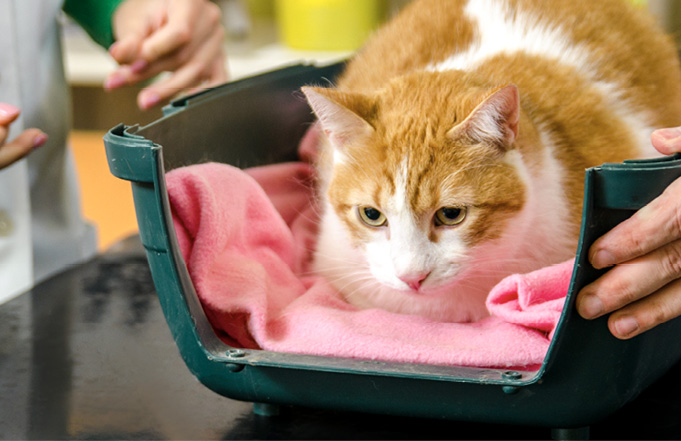
Small, simple additions and adaptations enhance the carrier experience.
If the cat is demonstrating stress-related body language:
- When did (cat’s name) start to become stressed today?
- How is (cat’s name) behavior different this trip?
- What changes might have occurred?
- Let’s talk further about ways to help (cat’s name) feel better about travel.
If the cat is demonstrating relaxed body language:
- It looks like (cat’s name) enjoys coming here. How were they for travel today?
DVM during history and exam:
- Identify if nausea (motion sickness) may be occurring.
- Emphasize the impact of the carrier on future vet visits.
- Ensure stress reduction is achievable.
- Prescribe a treatment plan that may include calming supplements/nutraceuticals, anti-anxiety medications, and/or anti-nausea medications to be administered prior to future vet visits and carrier training.
- Refer to a behavior consultant or positive reinforcement–based trainer as appropriate.
CSR/Tech during check out:
- Educate the client regarding low-stress medication administration.
- We really want to support both of you toward a more positive experience.
- I will contact you tomorrow to see how (cat’s name) acclimated to arriving home.
CSR/Tech during postvisit follow-up:
- How did (cat’s name) adapt once arriving home?
- Remember (Dr’s name) would like you to start the training plan for (cat’s name)
- Is there any part of the plan that seems confusing or challenging?
- I’ll check in with you regarding (cat’s name) progress next month (or sooner if a visit is scheduled)
For self-preservation, all species try to predict the earliest sign an adverse experience might occur. Learning through classical conditioning creates associations between stimuli or events and involuntary responses, such as emotions. For the client, thinking about scheduling a vet visit can trigger the same negative emotions as when they are actually trying to get the cat into the carrier. For the cat, the sight of the carrier often triggers all of the emotions from the previous vet experience. Fear can override the facts about the benefits of wellness care and available treatment. Focusing on client education and support regarding cat carriers and transportation is key to increasing feline wellness.
 |
Sherrie Yuschak, RVT, VTS (Behavior), KPA-CTP, Elite FFCP, is a faculty member of the Karen Pryor Academy for Animal Behavior and Training, where she contributes to curriculum and teaches several courses. She is a practice certification consultant for Fear Free and has collaborated on several Fear Free educational modules and certification standards and is a member of their speaker bureau. Yuschak’s experience encompasses general practice, academia, research, specialty practice, and consulting. |
Photo credits: Remains/iStock via Getty Images Plus, Sokratyks/iStock via Getty Images Plus, ©AAHA/Kate Moore, Phoenixns/iStock via Getty Images Plus




